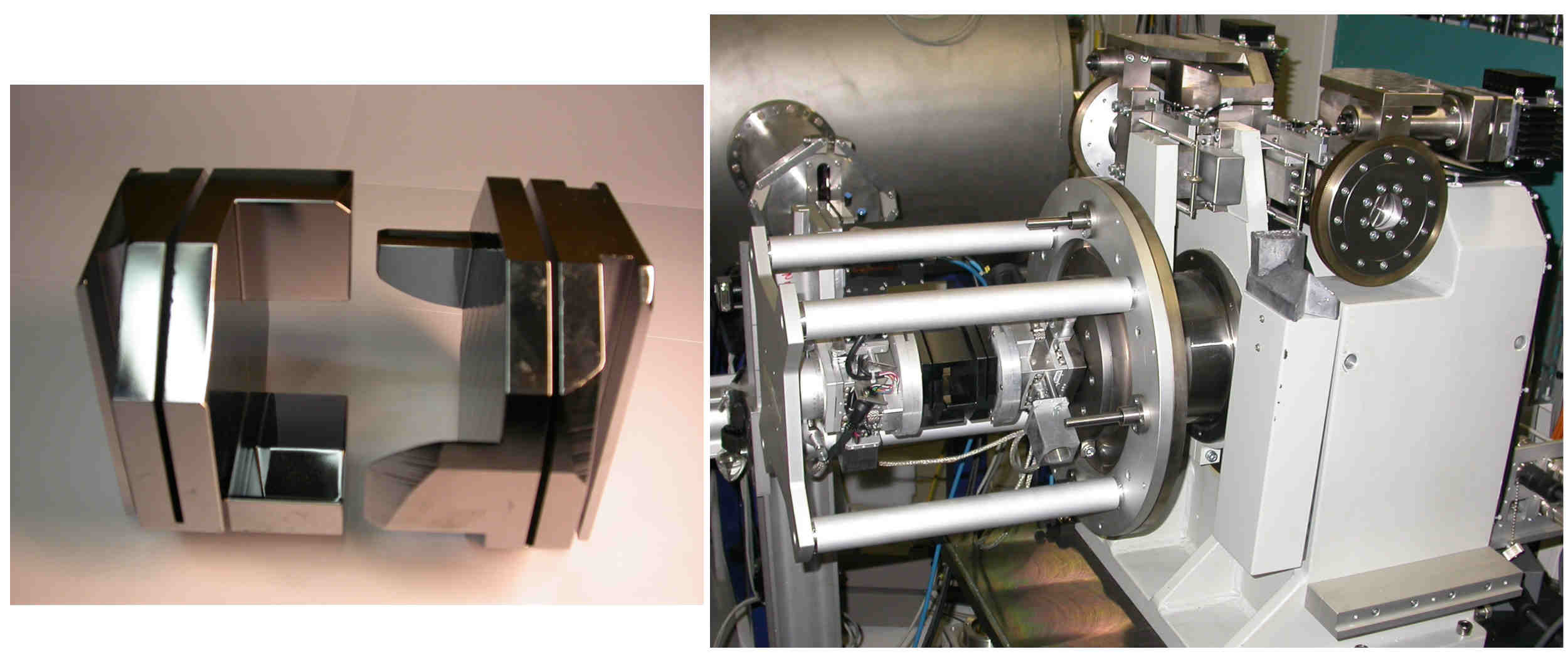- Home
- Optics elements
- High Resolution Monochromator
High Resolution Monochromator
High resolution monochromators with (sub-) meV energy resolution are mandatory for the investigation of vibrational properties in matter (e.g. phonons) and to prevent an overload of the detector system by the synchrotron radiation beam. Due to the fixed energies of the Mossbauer transitions and silicon as the material of choice for monochromator crystals, monochromators for each Mossbauer transition energy and often optimized for different applications have to be designed and manufactured.
Several designs have been developed and utilized. Common to all of them is the demand on high throughput, i.e. accepting the entire beam size and divergence, and on a high energy resolution. The four bounce nested channel-cut crystal design is adaptable to the various Mossbauer transition energies and is frequently used. The first HRM for 57Fe consists of an asymmetrically cut channel-cut Si(4 2 2) crystal (outer) and a symmetric channel-cut Si(12 2 2) crystal (inner). Based on the same idea HRMs for 149Sm and 129I have been designed and commissioned.

(Left)Crystals of the nested high resolution monochromator for 27.790 keV ( 129I isotope) with 1.0 meV energy resolution. The outer crystal is an asymmetrically cut Si(4 2 2) and the inner one a Si(24 4 0) channel-cut crystal.
(Right)KOHZU stage with the nested high resolution monochromator for 14.4 keV installed.
For better energy resolution an alternative scheme with independent (not nested) bounces was elaborated in case of the 57Fe transition energy. Our group is leading this development and has recently achieved an energy resolution of 0.47 meV at 14.4 keV keeping the flux as high as 5.5*108 photons/s (at 90 mA). This is even the best energy resolution achieved with crystal optics and applied to research. In a special geometry we were able to set-up a triple set of crystals allowing for fast switching between resolutions of 0.5, 1 and 2 meV. Meanwhile about 25 different HRMs for various nuclear transitions and applications were built-up. The most frequently used cases are summarized in Table.
In order to improve the mechanical resolution and stability we developed, based on the concept of two co-axial axes one sitting on the other, a new mechanics for the HRM in collaboration with KOHZU. An angular accuracy/resolution of 25nrad, and an encoder resolution of 2.66nrad has been achieved.
|
Isotope |
Resonance energy [keV] |
Outer reflection/ asymmetry parameter b |
Inner reflection/ asymmetry parameter b |
Energy resolution [meV] | Flux [photons/s] at 90 mA | Beam line |
|---|---|---|---|---|---|---|
|
57Fe |
14.412 |
Si(4 2 2) / -0.100 |
Si(12 2 2) / -1.0 |
6.4 |
1.4*1010 |
ID18 |
|
57Fe |
14.412 |
Si(4 2 2) / -0.100 |
Si(12 2 2) / -1.0 |
6.4 |
1.1*109 |
ID22N |
|
57Fe |
14.412 |
Si(3 3 3) / -0.11 |
Si(9 7 5) / -4.0 |
3.1 |
4.1*109 |
ID18 |
|
57Fe |
14.412 |
Si(9 7 5) / -0.53 |
Si(9 7 5) / -1.9 |
1.8 |
3.6*109 |
ID18 |
|
57Fe |
14.412 |
Si(9 7 5) / -0.12 |
Si(9 7 5) / -8.4 |
0.84 |
1.3*109 |
ID18 |
|
57Fe |
14.412 |
Si(9 7 5) / -0.028 |
Si(9 7 5) / -36 |
0.47 |
5.5*108 |
ID18 |
|
151Eu |
21.541 |
Si(4 4 0) / -0.064 |
Si(12 12 8) / -1.0 |
1.6 |
1.8*108 |
ID22N |
|
149Sm |
22.494 |
Si(8 0 0) / -0.089 |
Si(16 8 8) / -1.0 |
0.76 |
8.4*107 |
ID18 |
|
119Sn |
23.879 |
Si(6 4 2) / -0.043 |
Si(12 12 12) / -1.0 |
0.65 |
6.1*107 |
ID18 |
|
119Sn |
23.879 |
Si(6 4 2) / -0.043 |
Si(12 12 12) / -1.0 |
0.65 |
3.7*107 |
ID22N |
|
161Dy |
25.651 |
Si(4 4 4) / -0.10 |
Si(18 12 6) / -1.0 |
0.9 |
4.5*107 |
ID18 |
|
129I |
27.890 |
Si(4 2 2) / -0.246 |
Si(24 4 0) / -1.0 |
1.0 |
0.94*107 |
ID18 |
Some available high resolution monochromators for nuclear resonance scattering experiments at ID18 and ID22N. The design consists of two channel-cut crystals, outer and inner, which are 'nested'. The outer crystal is asymmetrically cut in order to match the divergence of the synchrotron radiation beam to the angular acceptance of the crystal. In order to achieve better energy resolution at 14.4 keV a two bounce design has been chosen. Numbers are for 90 mA electron beam current in the storage ring.
Additional information:
Tetsuya Ishikawa, Yoshitaka Yoda, Koichi Izumi, Carlos Kenichi Suzuki, Xiao Wei Zhang, Masami Ando, and Seishi Kikuta. Construction of a precise diffractometer for nuclear Bragg scattering at the Photon Factory. Review of Scientific Instruments, 63 (1992) 1015-1018.



